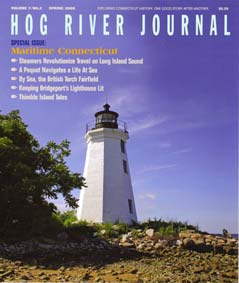by Elizabeth J. Normen
(c) Connecticut Explored, Spring 2009
Subscribe/Buy the Issue!
So often, the great arc of American history is portrayed in terms of westward expansion and manifest destiny. Connecticut played a small part in that movement, claiming and settling 3,500,000 acres in northeastern Ohio in the late 1700s. (Okay, not very far west, but it was the frontier! [See “West of Eden,” summer 2007])
During a summer course at the Frank C. Munson Institute of American Maritime Studies at Mystic Seaport Museum (part of my coursework towards my Master’s in American Studies at Trinity College), however, I experienced a paradigm shift in my way of thinking. Instead of mentally orienting myself as if standing on the East Coast looking west, I shifted my perspective to look east across the great Atlantic Ocean. It felt like turning a coin over and looking at its flip side. Suddenly it seemed so obvious that quite possibly “more” of Connecticut’s history had to do with it coastal location, hospitable ports, and navigable rivers than the traditional story of agriculture and “Go West, young man!” Benjamin Labaree summed up this sentiment in New England and the Sea (Mystic Seaport Museum, 1972), saying, “What the mariners of New England did was to transform their native land from a random collection of farming communities and give it a place of significance in the world at large.” Shipping agricultural surplus to distant markets, he noted, helped New England’s farmers prosper; making foreign-manufactured goods available to every country store increased the standard of living in small rural communities; and those foreign-made goods along with mariners’ experiences of the wider world—London, China, the Caribbean, and elsewhere—brought the world home to Connecticut. Of course what is left out of this narrative is the Connecticut economy’s connection to—and benefit from—the Caribbean and Southern U.S. slave economy.
To put together this issue we turned to the experts: editorial team member Dave Corrigan, curator of the Museum of Connecticut History and alumnus of Mystic Seaport’s curatorial department, and Bill Peterson, the Carl C. Cutler Chair of Maritime History and Material Culture at Mystic Seaport. They quickly generated a list of possible topics that screamed “expanded issue!”
We thank the Connecticut Humanities Council for funding this issue’s extra pages—all devoted to editorial content. You’ll find one additional feature (five instead of four) and six departments instead of the usual four. Please take a close look at our list of contributors (page 12) to find out more about the experts Bill and Dave tapped to bring you this issue’s stories. We offer sincere thanks to Dave, Bill, and intern Alan Patterson for their editorial leadership on this issue.
Thanks to the Connecticut Humanities Council
In addition to support for our expanded spring issue, we wish to thank the Connecticut Humanities Council for supporting Heritage Hot Spots for another year (page 68 in this issue), in which we are able to feature smaller heritage organizations free of charge. The old adage “great things come in small packages” aptly applies to the more than 30 organizations from throughout the state that have been featured as Heritage Hot Spots. If you’d like more information on how to participate please contact the publisher.
Also with CHC support, we’ll be expanding and enhancing our website with more content. New website features, including our lesson plans for teachers, will roll out during 2009, so check us out often. Most important, give us feedback so that we may continue to bring you more of what you’re interested in.
In the meantime, pull up a deck chair and enjoy a voyage through Connecticut’s salty and seafaring past!
Go to Spring 2009 Table of Contents

